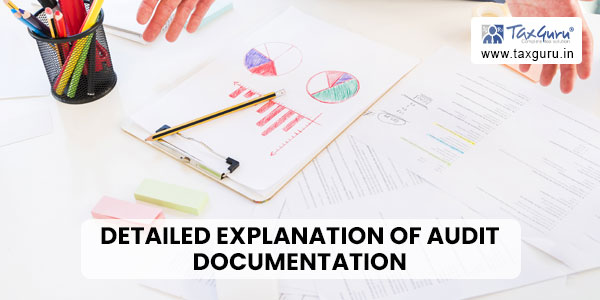Detailed explanation of audit documentation for a Private Limited Company in India, along with examples and case studies:
1. Audit Planning and Risk Assessment:
- Engagement letter: The engagement letter is a formal document that outlines the terms of engagement between the auditor and the company. It includes details such as the audit objectives, scope, responsibilities, and fees. An example of an engagement letter would be a document signed by the auditor and the company’s management, clearly stating the terms of the audit engagement.
Case Study: The auditor prepares an engagement letter for XYZ Pvt. Ltd., specifying the audit objectives, scope, and responsibilities. The engagement letter is signed by both the auditor and XYZ Pvt. Ltd.’s management, establishing the terms of the audit engagement.
- Audit plan: The audit plan outlines the strategy, scope, and procedures to be performed during the audit. It includes identifying key risks, assessing materiality, and planning the allocation of resources. The plan ensures that the audit is conducted effectively and efficiently.
Case Study: The auditor prepares an audit plan for ABC Pvt. Ltd., which includes an assessment of significant risks such as revenue recognition, inventory valuation, and related party transactions. The plan also includes the procedures to be performed to address these risks.
- Risk assessment documentation: This documentation includes records of the auditor’s assessment of significant risks, evaluation of internal controls, and planned responses. It helps the auditor identify areas where there is a higher risk of material misstatement.
Case Study: The auditor performs a risk assessment for LMN Pvt. Ltd. and identifies potential risks in the company’s revenue recognition process. The auditor documents the assessment, including the control weaknesses identified and the planned audit procedures to address the risks.
2. Financial Statements and Supporting Schedules:
- Trial balance: The trial balance is a summary of all accounts from the company’s general ledger. It lists the balances of each account and is used as a basis for preparing the financial statements.
Case Study: The auditor obtains the trial balance of PQR Pvt. Ltd., which lists the balances of various accounts such as cash, accounts receivable, accounts payable, and inventory.
- Financial statements: Copies of the audited financial statements, including the balance sheet, income statement, cash flow statement, and statement of changes in equity, are included in the audit documentation.
Case Study: The auditor reviews the financial statements of DEF Pvt. Ltd., which include the balance sheet showing the company’s assets, liabilities, and equity, the income statement showing revenues and expenses, and the cash flow statement depicting the company’s cash flows during the year.
- Supporting schedules: Detailed schedules and workings that support the amounts reported in the financial statements are included in the audit documentation. These schedules provide additional details and calculations related to specific accounts or transactions.
Case Study: The auditor prepares supporting schedules for LMN Pvt. Ltd., such as an inventory schedule showing the quantity and value of inventory items, a fixed asset register providing details of the company’s fixed assets, and an accounts receivable aging report to analyze the outstanding customer balances.
3. Working Papers and Audit Procedures:
- Audit programs: Audit programs are detailed plans that outline the specific audit procedures to be performed in each area. They specify the nature, timing, and extent of testing to be conducted.
Case Study: The auditor prepares an audit program for XYZ Pvt. Ltd.’s cash balance, which includes procedures such as reconciling bank statements, verifying cash receipts and payments, and reviewing cash controls.
- Analytical procedures: Analytical procedures involve the evaluation of financial information through the analysis of relationships and trends. The auditor documents the analytical reviews and procedures performed to identify significant fluctuations or anomalies.
Case Study: The auditor conducts analytical procedures for ABC Pvt. Ltd.’s revenue by comparing the current year’s revenue with prior years, industry benchmarks, and relevant internal data. The auditor documents the results and conclusions reached.
- Test of controls and substantive testing: The auditor performs tests of controls to assess the effectiveness of internal controls and substantive testing to test the accuracy and completeness of account balances and transactions.
Case Study: The auditor tests the controls over purchases and accounts payable in LMN Pvt. Ltd. by reviewing the segregation of duties, authorization procedures, and documentation trails. Substantive testing may involve selecting a sample of purchase transactions and verifying the supporting documents.
- Sampling documentation: When performing audit procedures on a sample basis, the auditor documents the sampling methodology used, sample selection, and results of testing.
Case Study: The auditor selects a random sample of sales invoices for DEF Pvt. Ltd. and verifies the accuracy of recorded sales amounts. The auditor documents the sample selection process, sample size, and the results of the testing.
- Supporting calculations: The auditor maintains worksheets and calculations used to determine materiality thresholds, estimate reserves, or perform other financial analysis.
Case Study: The auditor calculates the materiality threshold for PQR Pvt. Ltd. based on the company’s revenue and determines the impact on the financial statements. The calculations and rationale are documented in the audit file.
- Audit evidence: The auditor includes copies of documents obtained from the company as part of the audit evidence. These may include invoices, contracts, bank statements, and legal agreements.
Case Study: The auditor obtains copies of sales invoices, purchase orders, and bank statements from XYZ Pvt. Ltd. to verify the accuracy of revenue, expenses, and cash balances.

4. Auditor’s Communications:
- Management representation letter: The management representation letter is a letter from the company’s management to the auditor, providing written representations on matters related to the audit.
Case Study: The auditor requests management representation from ABC Pvt. Ltd., and management provides a letter stating that they have provided all relevant information and disclosed any known fraud or non-compliance.
- Auditor’s communication: Correspondence between the auditor and the company, including management letters, significant findings, and recommendations, is included in the audit documentation.
Case Study: The auditor communicates significant internal control weaknesses identified during the audit to the management of LMN Pvt. Ltd. The communication is documented in the audit file.
5. Review and Reviewer’s Notes:
- Review notes: The audit team maintains review notes that capture comments and queries made during the review of audit workpapers and documentation.
Case Study: The audit team reviews the working papers of DEF Pvt. Ltd. and makes notes regarding missing documents, insufficient evidence, or unclear explanations.
- Reviewer’s notes: The reviewer or partner responsible for overseeing the audit engagement provides comments and feedback on the audit documentation.
Case Study: The engagement partner reviews the audit documentation for PQR Pvt. Ltd. and provides feedback and suggestions for improvement in the working papers.
6. Final Audit Reports:
- Audit opinion: The auditor issues the final audit report, which provides an opinion on the fairness of the financial statements.
Case Study: The auditor prepares an audit report for XYZ Pvt. Ltd., expressing an unqualified opinion that the financial statements present a true and fair view of the company’s financial position and performance.
- Management letter: A separate report may be prepared by the auditor, addressing internal control weaknesses, recommendations, and other matters identified during the audit.
Case Study: The auditor prepares a management letter for ABC Pvt. Ltd., highlighting control weaknesses in the company’s inventory management process and providing recommendations for improvement.
It’s important to note that the examples and case studies provided are for illustrative purposes only, and the actual audit documentation may vary depending on the specific circumstances of each company and the requirements of the auditing standards. Auditors should comply with the auditing standards issued by the Institute of Chartered Accountants of India (ICAI) and maintain comprehensive and well-organized audit documentation to support their findings and conclusions.
******
Author is A Practicing Chartered Accountant with over 5 years of rich experience in Company Law, Audits, Accounts & taxation. She is keen in streamlining business accounts of the Company and provide Business advisory services She can be connected on sweta@caswetamakwana.com or on 9819244185.





